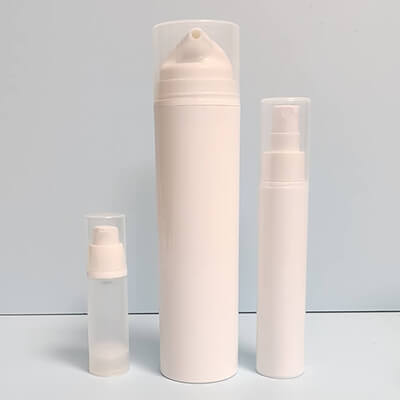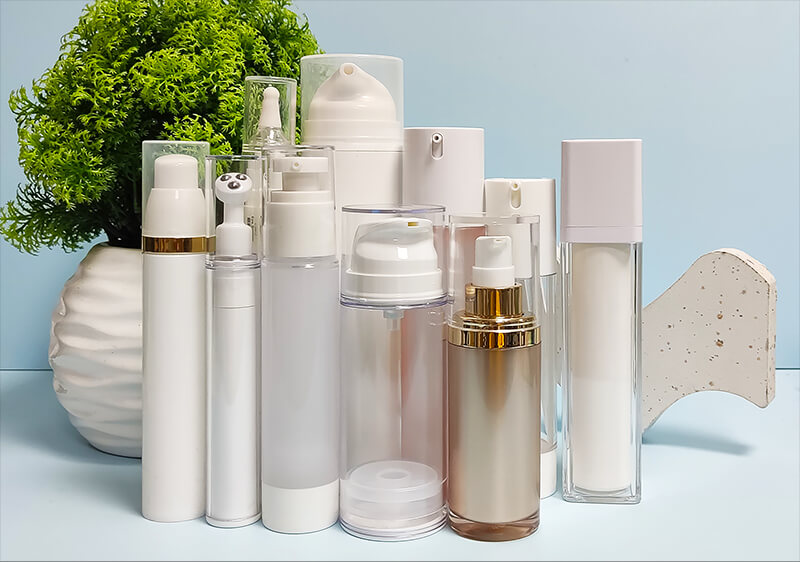Airless pump bottles have become increasingly popular in recent years due to their ability to dispense products without the need for air. These bottles are designed to preserve the quality and effectiveness of the contents by preventing air from entering the container, which can cause oxidation and contamination.
As someone who works in the cosmetic and personal care industry, I understand the importance of choosing the right packaging for products. The material of the airless pump bottle can have a significant impact on the product’s shelf life, effectiveness, and overall quality.
In this comprehensive guide, I will provide an overview of the three main materials used in airless pump bottles: Polypropylene (PP), Polyethylene terephthalate glycol (PETG), and Acrylonitrile Styrene (AS). I will discuss the properties, advantages, and disadvantages of each material, as well as their common applications. Additionally, I will provide an overview of other materials used for airless pump bottles and the factors to consider when choosing the material of an airless pump bottle.

Whether you are a consumer looking to choose the best packaging for your favorite products or a manufacturer seeking to select the most suitable material for your products, this guide will provide you with valuable insights to help you make an informed decision.
PP (Polypropylene) airless pump bottles
Polypropylene is a thermoplastic polymer that is widely used in the manufacturing of airless pump bottles. It is a lightweight and durable material that can withstand high temperatures, making it suitable for a variety of applications.

Advantages:
- Polypropylene is a low-cost material, making it an affordable option for manufacturers and consumers.
- PP airless lotion bottle has a wide range of capacity options, it can range from 15ml-200ml.
- It is resistant to chemicals, making it suitable for storing a wide range of products, including skincare, hair care, and cosmetics.
- Lightweight and shatter-resistant, which makes it easier to transport and reduces the risk of damage during transportation.
Disadvantages:
- Polypropylene is not as impact-resistant as other materials, which can result in cracking or breaking if dropped.
- It can be difficult to recycle, which can impact its sustainability and environmental impact.
Common Applications:
- Skincare and facial products, such as creams, serums, and lotions.
- Hair care products, such as conditioners, and hair masks.
- Cosmetics, such as foundation, BB cream, and concealer.
Overall, PP airless pump bottles are a popular choice due to their affordability, chemical resistance, lightweight and shatter-proof. However, the material’s low impact resistance and difficulty to recycle can be a drawback for some consumers and manufacturers.
PETG (Polyethylene terephthalate glycol) airless pump bottles
PETG is a thermoplastic polyester material that is commonly used in the manufacturing of airless pump bottles, nomally single-layer ones. It is a highly durable material that offers excellent clarity and impact resistance.
Advantages:
- PETG is highly durable and resistant to impact, making it a popular choice for products that require a high level of protection.
- It is high level transparent, allowing the maximum visuality to the contents of the bottle, giving comsumer a luxury look.
- PETG is recyclable, making it a more sustainable option compared to some other materials.
Disadvantages:
- PETG is a more expensive material compared to polypropylene.
- It may not be suitable for storing products that contain strong solvents or aggressive chemicals.
Common Applications:
- Skincare and facial products, such as serums, creams, and gels.
- Hair care products, such as shampoos, conditioners, and hair masks.
- Sunscreen and other UV protection products.
- Fragrances and perfumes.
PETG airless pump bottles offer excellent durability and transparency, making them an excellent option for a wide range of high-end products. The material’s recyclability also makes it a more sustainable option compared to some other materials. However, its higher cost and potential incompatibility with certain products may be a drawback for some manufacturers and consumers.
AS (Acrylonitrile Styrene) airless pump bottles
AS is a thermoplastic material that is a blend of acrylonitrile and styrene. It is a strong and durable material that offers excellent resistance to impact and chemicals. The AS airless bottle is usually maked as double-layer bottle, and AS material usually used as outer bottle, for the inner bottle and the airless pump, it usually is PP material.
Advantages:
- AS airless pump bottles offer excellent resistance to impact and chemicals, making them suitable for a wide range of products.
- The material has a high level of transparency, making the airless bottle more stylish looking, great for high-grade cosmetic packaging.
- AS is a recyclable material, making it a more sustainable option compared to some other materials.
Disadvantages:
- AS is a more expensive material compared to polypropylene.
- The material may not be suitable for storing products that contain high levels of alcohol.
Common Applications:
- Skincare and facial products, such as creams, serums, and lotions.
- Hair care products, such as shampoos, conditioners, and hair masks.
- Fragrances and perfumes.
- Nail care products, such as nail polish and nail treatments.
AS airless pump bottles offer excellent durability and chemical resistance, making them an ideal choice for a wide range of products. The material’s high level of transparency and recyclability also make it a more sustainable option compared to some other materials. However, its higher cost and potential incompatibility with certain products may be a drawback for some manufacturers and consumers.
Conclusion
In conclusion, airless pump bottles are a popular and effective packaging option for a wide range of products, particularly in the beauty and personal care industry. Understanding the different materials available for airless pump bottles is essential in selecting the most suitable packaging for a product.
PP, PETG, and AS are the most commonly used materials for airless pump bottles. Polypropylene is a low-cost and chemically resistant material, while PETG offers excellent durability and transparency. AS provides excellent resistance to impact and chemicals. Each material has its advantages and disadvantages, and the final choice will depend on the product being packaged and the manufacturer’s and consumer’s preferences.
When you selecting airless pump bottles, maybe cost is your first priority, but this depends on your branding and your product. It is also essential to consider the environmental impact of the chosen material. Recyclability is a crucial factor to consider, and both PETG and AS are more recyclable compared to PP.
In summary, choosing the right material for airless pump bottles is a crucial decision that can impact your product’s efficacy, sustainability, and consumer perception. By considering the advantages and disadvantages of each material and weighing them against the product’s needs, you can select the most suitable material for their airless pump bottles.



0 Comments